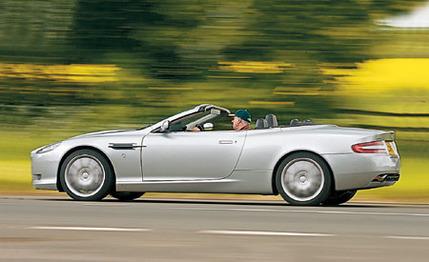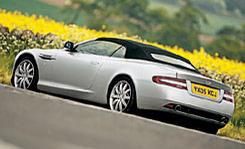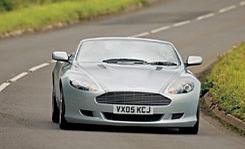 First Drive Review
First Drive Review
What could be better--more beautiful, more attention-grabbing, more perfect for a jet-set lifestyle--than an Aston Martin DB9?
The answer is an Aston Martin DB9 Volante, the convertible version of one of the world's loveliest cars.
We can argue that the fixed-roof coupe, with an inevitably stiffer body shell, is lighter, faster, and more rewarding to drive--and $13,500 cheaper--but buyers of automotive exotica, especially in the United States, always veer toward a convertible. Aston knows that, so when it developed its VH platform--the architecture that will eventually be used for its three model lines--the plan was for closed and open versions with a minimum of modifications.
The beautiful DB9 coupe--featured in our supercar comparison last month--has been around for a year now, and it's time for it to be joined by the DB9 Volante.
The VH structure of bonded aluminum sheet and extrusions needed few changes for the DB9 Volante that, although it doesn't have the same torsional stiffness as the coupe, suffers much less from losing its head than most of its competitors. So it doesn't have the cowl shake or creaks and groans that afflict many convertibles. On bad road surfaces there is some murmuring through the steering, but it's not enough to spoil the driving experience. And with the top down, there is more opportunity to savor the aural delights of that mighty V-12 engine.
The Volante weighs 130 more pounds than the coupe. It eschews the retractable hardtops that have recently become so fashionable in favor of a conventional folding fabric roof. The top is superlative for its type, fitting snugly so that wind noise is negligible, even at 100 mph, and powering down and under a flush body panel simply by pulling back a switch on the center console. There are no catches to be released or secured, and the whole process of putting the roof up or down takes just 17 seconds.
 Once open to the elements, wind buffeting is bearable up to about 60 mph but beyond that would benefit from a blocker that Aston is still developing. That, however, will render the rear seats unusable. Now it's true that the rear seats of the DB9 coupe are unsuitable for all but the smallest and youngest human beings, but that is partly because of the difficulty of getting into them. Top down, the rear seats don't gain any size advantage, but they do become more accessible.
Once open to the elements, wind buffeting is bearable up to about 60 mph but beyond that would benefit from a blocker that Aston is still developing. That, however, will render the rear seats unusable. Now it's true that the rear seats of the DB9 coupe are unsuitable for all but the smallest and youngest human beings, but that is partly because of the difficulty of getting into them. Top down, the rear seats don't gain any size advantage, but they do become more accessible.
Occupants are protected in a roll-over accident by strengthened windshield pillars and two pop-up hoops behind those rear seats. They deploy only when sensors detect that the car might be headed for trouble. There is no manual override for these roll hoops; indeed, the handbook advises owners planning high-g cornering on a track to run with the top down because if the hoops pop up, they will break the softtop's rear window, which is glass.
 Track-day specialists will prefer the DB9 coupe in any case. The Volante isn't meant for such athletics. It has a more gentle suspension--softer springs and a thinner front anti-roll bar, with the rear bar deleted. Aston judged this setup more suited to the cruising for which the convertible will likely be used. Otherwise, mechanically, open and closed cars are identical.
Track-day specialists will prefer the DB9 coupe in any case. The Volante isn't meant for such athletics. It has a more gentle suspension--softer springs and a thinner front anti-roll bar, with the rear bar deleted. Aston judged this setup more suited to the cruising for which the convertible will likely be used. Otherwise, mechanically, open and closed cars are identical.
At the start of production last year, DB9s were available only with six-speed ZF automatic transmissions, where gears were selected via dash-mounted buttons and paddles that turn with the steering wheel. Our Volante had this transmission, which operates nicely in either automatic or manual mode, but there is now the option of a six-speed manual made by Graziano in Italy and shared with the V-8 Vantage. Choosing do-it-yourself gearshifting with a short central lever and a clutch pedal saves $4000.
Although it is not as focused a high-performance car as the DB9 coupe, there are few disadvantages to offset the joys of open-air driving. With the roof up, the hard-to-reach rear seats are somewhat claustrophobic, and the small, shallow rear window limits the driver's rear vision. Aston says the roof stays firmly in place at its maximum speed, which is limited to 165 mph, 21 mph less than the coupe. It reckons that's as fast as convertible customers will want to go, top up or down.
And what of its looks? The DB9 is the work of Aston's erstwhile designer Henrik Fisker, but it's clearly influenced by Ian Callum's DB7. That predecessor was among the all-time automotive beauties but lost its perfect proportions when the roof came off. The longer, lower, and more lithe DB9, sans lid, retains its winning style. The DB9 Volante pleases the aesthetes as much as the extroverts.